Kerala, a state in the south-west region of the country, is a lush paradise of pretty mountains and valleys. It shares border with Karnataka to the north, north-east and Tamil Nadu to the south and south-east. To the west, 200-300 km away from its pristine coastline, are the Lakshadweep islands. Nature's bounty, vibrant culture and an exotic cuisine bespeak the land's tourist slogan "God's Own Country".
The Kerala State was formed on November 1, 1956 after the reorganisation of states on a linguistic basis. An eventful history and a rich heritage of arts and science make the state unique. The cultural heritage of the land paved way for the evolution of a progressive society.
The state has a reputation for communal harmony. Kerala was the first place in the Indian sub-continent to host Christianity and Islam. The country's first church and mosque are situated at Kodungallur in the state.
The state is noted for a serene waterscape comprising rivers, backwaters and ponds.Its another claim to fame are a variety of spices which attracted traders from various foreign countries since ancient times.Colourful festivals and classical art forms are another hallmark of the state.
Kerala, which is known as God's Own Country attracts a lot of tourist every year with its physical and natural beauty as well as with its rich cultural heritage, which fascinates the tourists. All these art forms are performed during some celebration or festivity. The art and culture of Kerala portrays various dance forms and martial arts performed with the accompaniment of vocal and instrumental music. These art forms are performed during festivals as well shows are also performed for the convenience of tourists.
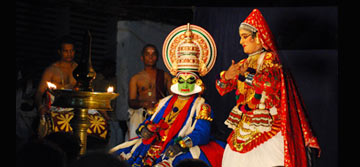
Kathakali is one of the classical dance drama of kerala based on the guidelines written in Natya Sastra. The costumes and makeup are ornamental, colourful and elaborate so that the gestures and expressions of the performer are easily seen and understood. The performers do not speak or sing but enact the story through hand gestures, body movements and facial expressions especially of the eyes. The themes of this art form are from mythology of Indian culture.

This is another art form with its distinct simplicity of presentation and its frank, outspoken wit and humour. The songs are in simple Malayalam and the techniques employed are not rigid. The performer will have the freedom to tease even the audience during his performance. Though Thullal is based on the classical principles of Naatya Saastra, it is said to have been a modification of Koothu. It is organized by Kunjan nambiar, a veritable genius and one of the foremost poets of Kerala.
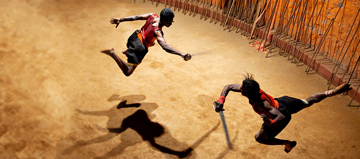
It is the most ancient art form of kerala.Kalarippayattu is as old as the great Indian philosophy and the Vedas.Kalarippayattu is considered by many as the most comprehensive of all the martial traditions because it has an excellent system of physical training and a very effective self defense techniques - both armed and unarmed.
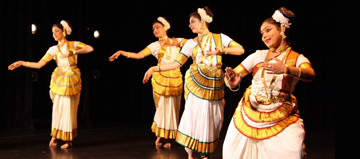
Mohiniyattam is a dance form originated in Kerala. It is closely related to Bharathanatyam of Tamil Nadu, which was originally called 'Dasiyattam.In Mohiniyattam Mudras and facial expressions are more important than the rhythmic steps. Costumes and ornaments of Mohiniyattam have much in common with female characters of Koodiyattam and Kathakali. Major contributions to this art form were given by Maharaja Swathi Thirunal.The accompaniments for Mohiniyattam are Vocal, Veena, Venu, Maddalam and Idakka.
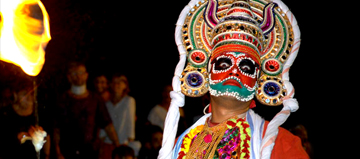
Mudiyettu is the story of the war of Bhadrakaali with the two notorious Asuras Daarikan and Daanavendran, eventually Killing them.Mudiyettu is presented without much of `mudras', facemasks and facial expressions, but with facial make-ups and `chutti' (artwork done on face with rice paste) which makes the characters simple and more acceptable to the viewers
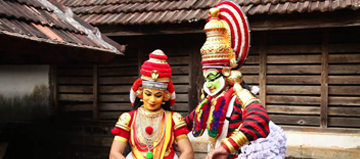
Kerala has a rich tradition of artist rituals associated with worship of Devi (GodMother) in the form of Bhadrakaliand it can be traced to the region's strong Dravidian and Tribal cultural roots. It has remarkable similarity to those of African and South American Tribal rituals.Recent findings in Anthropology point towards a common heritage of all human races. All these rituals are performed in places of worship called "Kavu" (roughly translated as grove) or small temples.
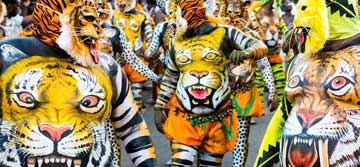
Pulikali is also known as Kaduvakali, is a 200 year old art, is a colorful recreational folk art from the state of Kerala. Literal meaning of Pulikali is the 'play of the tigers' hence the performance revolve around the theme of tiger hunting. The folk art is mainly practiced in Thrissur (Trichur) and Palghat districts of Kerala. Best place to watch the show is Swaraj Ground at Thrissur.
on the fourth day of Onam, where Pulikali troupes from all over the district assemble to display their skills. Men numbering three or more wear the masks of tiger, paint their bodies in yellow and black stripes and dance to the sound of udukku and thakil. Usually, they enact as being hunted by a game hunter or preying on goats.
Kerala tourist places are the most popular destinations in India. Kerala is well known for its Backwaters, Beaches, Wild life sanctuaries, Hill stations and Ayurvedic treatments. Kerala Beaches are spread along the 900 km Arabian Sea coastline and it become one of the main attraction in Kerala Tourism. The Kerala Backwaters are a network of interconnected brackish lagoons and lakes lying parallel to the Arabian Sea coast. SightSeeing in Kerala is very interesting.

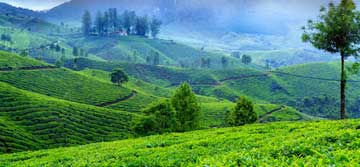

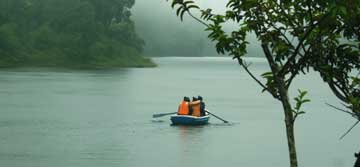
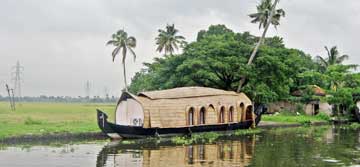
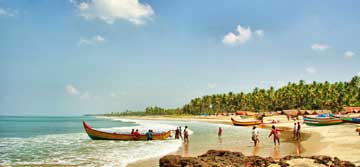

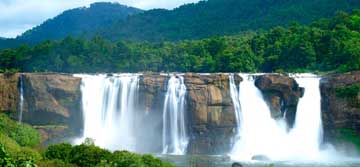
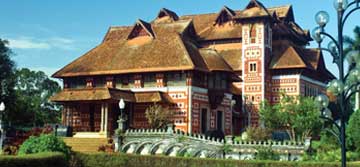
Kerala food is spicy yet delicious. The distinctive cuisine of Kerala is prepared using the ingredients available locally. Seafood is also famous here. The local food includes a lot of coconut as it is available in plenty and is tasty. The oil used for cooking is mainly coconut or vegetable oil. Sea food such as fish, crabs, shelfish, lobsters are included in everyday cooking especially in the coastal regions. Smaller fish are dried salted and pickled. An average Malayali is very liberal in the use of spices and commonly use green chillies, cumin, coriander, clove, cinnamon, cardamom, dried red chilles and coriander leaves adds an irresistible flavour. Kerala tourist come to Kerala to have the mouth watering food stuffs.
Tapioca and plantain cultivation is profuse in kerala and finds a great use of vegetables in both main dishes and snacks. The Kozhikodan Biriyani, Fish curry, Prawn masala are familiar favourites among non-veg food in Kerala.

The order in which the food is served is of physiological, cultural and religious significance. On the bottom left are placed the Pappadam and Chips. Above these the pickles and Pulli Inji are placed. Now from left to right are served Thoran, Olan, Avial, Kalan, Erisseri and Pachadi. In the middle of the leaf rice is served. On it Parippu, Sambar, Rasam and Curd may be served as per the course. The Payasam/ Pradaman is served between the Rasam and Curd courses. The courses get lighter as the meal proceeds and the addition of digestive tidbits such as Pulli Inji or Lime Pickle ensure complete digestion. Pradhaman or Payasam may be of many kinds but the favorite is Pal Payasam. The order in which the food is served is said to signify the spiritual progress of the soul from materialism (spicy) towards spiritualism (refined and subtle).
Traditional clothing of Kerala reflects the simplicity and inherent lifestyle of Malayalis. Most of the people of both genders commonly wear white attires. The main dresses which individuals wear are highly traditional. The form of costume worn by the people like Neriyathu and Mundu has a white cloth piece having golden zari borders representing royalty for men and women .

Mundum Neriyathum is a traditional dress worn by women in Kerala. The traditional piece is Mund that is the lower cloth consisting 2 pieces of cloth. It is worn around hips and below the navel. It is a woven cloth this is completely made of pure cotton. Mund is very easy and comfortable to wear during summer. This is a white or creamy dress with colorful strips known as Kara or border. There is a special kind of blouse which is worn with Mundu covering the entire navel.
The upper part of the garment is Neriyathu which is worn over the blouse. Its ends are instead inside the Mundu. It is worn like a sari in a diagonal manner. The dress worn everyday and during festive seasons women wear some extraordinary outfits with an ornamental Kara or a special type of border which is either golden, copper coated or artificial colored with peacock or temple design.
During Onam, the popular festival of Kerala, women participate in a folk dance well-known as Kalkotti Kalli Dance. That moment they wear saris with lots of accessories such as jewelleries.

Most of the males are conservative even more than women in Kerala. To keep with their tradition, they wear white clothing which is the universal color for both sexes. The main clothing is Mundu for men, which is a long garment. It needs to be tucked around the waist and reaches to the ankle. There are many men who also prefer to wear it above their waist, but higher caste people drape a cloth which looks-like a towel over their shoulders. This is worn by men of all religions in Kerala.
Men wear Kasavu Mundu, mostly in rural areas. The clothing is made of cotton with a silk border. Kaily or Lungi is informal attire for Keralites. However, when they move out of their homes, they at least put a shirt and Mundu.
The land of festivals, Kerala is renowned for Onam, the most important festival in Kerala. Famous boat races are held at this time in the state. Some of the popular Hindu festivals are Maha Shivratri, Navaratri, Vishu and Deepavali, which are also celebrated across the state. The Muslim communities in the state celebrate Bakri Id, Muharram, Miladi Sheriff and Ramadan. Kerala has a significant Christian population. They celebrate Easter and Christmas. However, the popularity of Christmas is not confined among the Christians alone, but has a state-wide appeal.
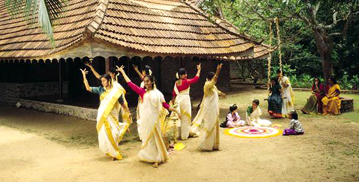
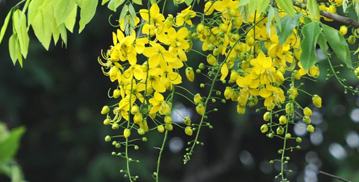

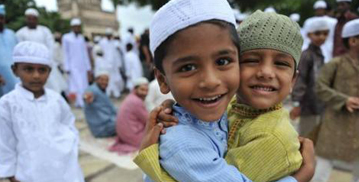
In Kerala, the three major seasons are summer (February-May), monsoons (June-August and October-November) and winter (December-January) with a pleasant interval of mild weather between August and October. There is no fall season, with any noticeable falling of leaves. Instead, towards the height of summer (March-April-May), there is a partial falling of leaves. It would still be hot summer, as your perspiring body would tell you.
It gets increasingly hot during the summer season from February to May. A few showers in March or April might cool things a bit (not much). Temperatures typically reach 35 degrees centigrade and the blazing sun is no pleasant experience. Tree leaves become dry and begin to fall, though few trees become completely bare of leaves.